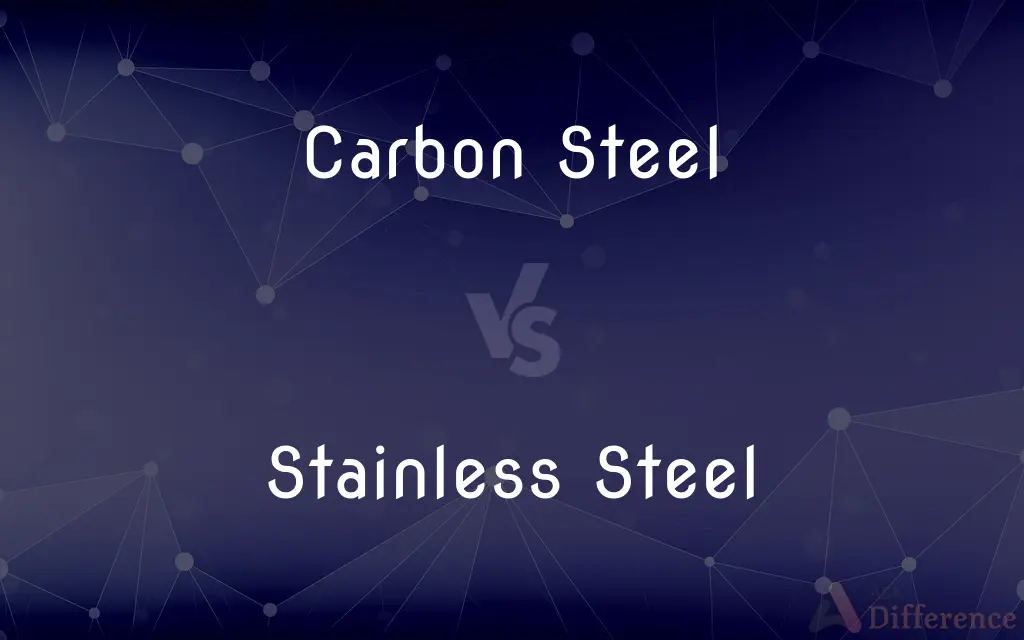Carbon Steel vs. Stainless Steel — What's the Difference?
By Urooj Arif & Fiza Rafique — Published on August 24, 2024
Carbon steel is an alloy primarily made of iron and carbon, known for its strength and malleability, while stainless steel includes chromium, offering corrosion resistance.

Difference Between Carbon Steel and Stainless Steel
Table of Contents
ADVERTISEMENT
Key Differences
Carbon steel, an alloy of iron and carbon, boasts high strength and is widely used in applications requiring durability and toughness. The carbon content in carbon steel can vary, leading to different grades with varying degrees of strength and ductility. On the other hand, stainless steel is distinguished by its chromium content—at least 10.5%—which forms a protective layer on the surface, granting it superior resistance to rust and corrosion.
While carbon steel is preferred for its strength and ease of machining in construction and manufacturing, its susceptibility to corrosion limits its use in environments prone to rust. Stainless steel, although generally more expensive and harder to work with, is chosen for applications where resistance to corrosion is paramount, such as in cutlery, kitchen appliances, and medical equipment.
Carbon steel is classified into three categories: low, medium, and high carbon steel, each offering different properties in terms of hardness and malleability. Stainless steel, however, is categorized based on its crystalline structure, including austenitic, ferritic, and martensitic, each with unique properties and applications. This classification affects the material's mechanical properties and resistance to corrosion.
The presence of other alloying elements also differentiates these steels. Carbon steel may contain trace amounts of other elements but focuses on carbon content for its characteristics. Stainless steel, in addition to chromium, often includes nickel, molybdenum, and nitrogen, enhancing its corrosion resistance and mechanical properties.
When deciding between carbon steel and stainless steel, considerations include the specific application's environment, mechanical requirements, and cost. Carbon steel is often chosen for its strength and cost-effectiveness in structural applications, while stainless steel is preferred in environments where corrosion resistance is critical.
ADVERTISEMENT
Comparison Chart
Composition
Iron, carbon
Iron, chromium, nickel, molybdenum
Corrosion Resistance
Prone to rust without protective coatings
High resistance to corrosion
Strength
High, varies with carbon content
High, varies with alloy composition
Cost
Generally less expensive
More expensive due to chromium content
Applications
Construction, tools, machinery
Cutlery, medical devices, architecture
Machinability
Easier to machine
Harder to machine, depending on grade
Categories
Low, medium, high carbon steel
Austenitic, ferritic, martensitic
Durability
Durable, but can corrode
Durable and maintains appearance
Weldability
Good, varies with carbon content
Good, especially in austenitic grades
Compare with Definitions
Carbon Steel
Categorized based on carbon content affecting its properties.
High carbon steel is used for cutting tools due to its hardness.
Stainless Steel
Used where cleanliness and longevity are crucial.
Medical instruments are made from stainless steel for sterilization.
Carbon Steel
An alloy of iron and carbon known for its strength and malleability.
The construction beams are made of carbon steel for enhanced durability.
Stainless Steel
An alloy containing chromium, offering excellent corrosion resistance.
Stainless steel cutlery remains rust-free even with regular washing.
Carbon Steel
Cost-effective for a wide range of industrial applications.
Carbon steel is chosen for its affordability in manufacturing machinery.
Stainless Steel
Categorized by crystalline structure affecting its use.
Austenitic stainless steel is widely used in kitchenware for its non-magnetic properties.
Carbon Steel
Prone to corrosion but highly durable with proper treatment.
Carbon steel pipes are coated to prevent rust in outdoor applications.
Stainless Steel
More expensive than carbon steel due to its alloying elements.
Stainless steel appliances are pricier but offer a modern look and durability.
Carbon Steel
Used in applications requiring high strength and toughness.
Carbon steel is the preferred material for high-quality tools.
Stainless Steel
Offers a balance of strength, aesthetics, and resistance to corrosion.
Architectural facades often use stainless steel for its lasting shine and strength.
Stainless Steel
Alternative spelling of stainless steel
Common Curiosities
Is stainless steel as strong as carbon steel?
Stainless steel is strong but its strength varies with alloy composition; some carbon steels can be stronger due to higher carbon content.
Which steel is better for outdoor applications?
Stainless steel is better for outdoor applications due to its superior corrosion resistance.
What is the main difference between carbon steel and stainless steel?
The main difference is the presence of chromium in stainless steel, providing corrosion resistance.
Why is stainless steel more expensive than carbon steel?
The addition of chromium and other alloying elements increases the cost of production.
What makes stainless steel 'stainless'?
The chromium in stainless steel forms a passive layer that protects it against corrosion.
How do you identify carbon steel from stainless steel?
Stainless steel typically has a shinier surface and doesn’t rust easily, distinguishing it from carbon steel.
Can carbon steel become stainless steel if chromium is added?
Adding chromium to carbon steel in sufficient amounts can create an alloy with properties similar to stainless steel.
Which steel is easier to weld?
Weldability varies; carbon steel is generally easier to weld, but stainless steel also welds well, especially austenitic grades.
What are the environmental impacts of using carbon steel and stainless steel?
Both have environmental impacts in production and disposal, but stainless steel’s durability and recyclability may reduce its overall impact.
Can carbon steel be protected against corrosion?
Yes, through protective coatings and treatments like galvanization.
Is all stainless steel non-magnetic?
Not all; austenitic stainless steel is generally non-magnetic, while other types can be magnetic.
How does carbon content affect carbon steel properties?
Higher carbon content increases strength and hardness but reduces ductility and weldability.
Why is carbon steel preferred in construction?
Its high strength, durability, and cost-effectiveness make it suitable for structural applications.
Can stainless steel rust or corrode?
Under extreme conditions or improper maintenance, stainless steel can corrode, but it is much less likely than carbon steel.
How do I choose between carbon steel and stainless steel for a project?
Consider the environment (corrosive or not), mechanical requirements, and budget to decide the most suitable material.
Share Your Discovery

Previous Comparison
Heptane vs. N-Heptane
Next Comparison
Foaming Cleanser vs. Hydrating CleanserAuthor Spotlight
Written by
Urooj ArifUrooj is a skilled content writer at Ask Difference, known for her exceptional ability to simplify complex topics into engaging and informative content. With a passion for research and a flair for clear, concise writing, she consistently delivers articles that resonate with our diverse audience.
Co-written by
Fiza RafiqueFiza Rafique is a skilled content writer at AskDifference.com, where she meticulously refines and enhances written pieces. Drawing from her vast editorial expertise, Fiza ensures clarity, accuracy, and precision in every article. Passionate about language, she continually seeks to elevate the quality of content for readers worldwide.













































